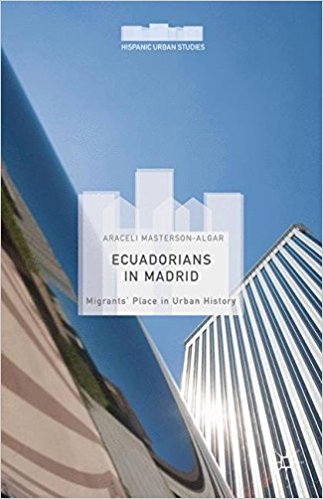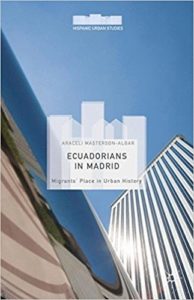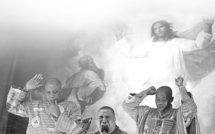
 In the decade following the financial collapse of Ecuador, hundreds of thousands of migrants left the country to make a home elsewhere. For a sizable portion of this population, Madrid was the ultimate destination. From 1998 until 2008, the Spanish capital’s immigrant population swelled significantly; the Ecuadorian community quickly became the biggest and the best organized within this emergent migrant metropolis.
In the decade following the financial collapse of Ecuador, hundreds of thousands of migrants left the country to make a home elsewhere. For a sizable portion of this population, Madrid was the ultimate destination. From 1998 until 2008, the Spanish capital’s immigrant population swelled significantly; the Ecuadorian community quickly became the biggest and the best organized within this emergent migrant metropolis.
In Ecuadorians in Madrid, Araceli Masterson-Algar, Associate Professor of Spanish at Augustana College, sets out to explore the role of this collective in shaping everyday urban life on both sides of the Atlantic. She is keen to draw out their influence both within their adopted homeland and within the landscapes they seemingly left behind in Ecuador, with particular attention paid to recent urban developments in Quito. This is an ambitious task that weaves together an array of sites and scales. Through mostly ethnographic methods, Masterson-Algar sheds light on migrant urban life in millennial Madrid, where the city could prove at once hostile and beguiling to its newest residents.
In the first chapter, the author places recent Ecuadorian migration to Madrid against the city’s longer built history. Here she explores the contradictory and complicated narratives around hispanidad that have sought to bring together the former sites of colonial domination with the old metropole. In doing so, she examines the discourses and political projects that have bound together Madrid and Quito, legitimating Ecuadorian claims for space within the Spanish nation. In examining these relations between Madrid and its former colonies, the author does a great job demonstrating how the contemporary metropole continues to rely on those sites for status and prestige. Madrid emerges not only as a major European capital, but also as the central node within a network of Latin American investment. Exporting Spanish expertise and infrastructure throughout the Hispanic world has allowed Madrid to flourish. While Madrid is often examined through its overreliance on EU funding and audacious construction projects, here the city emerges as an important power center within a north-south network of transnational interests. By displacing the focus from European networks of exchange, the author illuminates an alternative means of comprehending the Spanish capital. This is an important intervention into the literature on urban Spain, and I would welcome more work that examines these dynamics.
By focusing on specific sites and projects, Masterson-Algar brings to life the connections between Madrid and Quito. Her analysis of the metro as a modernizing technology is compelling, allowing her to explore the class dynamics that have inflected Madrid’s urbanization. Here she moves between historical considerations of working class neighborhoods with contemporary demographic change. This transportation technology, which promises a kind of utopian urban future of mobility and movement, also allows for her to travel back to Quito, where she explores the politics surrounding the imposition of a new metro system in the city’s vast and rugged valley. Her analysis, which draws on films and advertisements in addition to interviews and archival material, draws attention to the myriad promises of transportation as a tool for urban transformation. The metro is here imbued not only with technocratic possibility, but also with dreams of modernity and efficiency. Here, too, we are able to see how experiences of the everyday—that is, Ecuadorians riding the Madrid metro—produced a common sense that then influenced development agendas in Quito. In doing so, the author complicates the standard narratives of modernization and development by highlighting the mundane processes and quotidian experiences that contribute to grand and totalizing projects.
The other great strength of this book is its illuminating account of migrant sociability and collective life. The author’s clear analysis of urban parks as sites of leisure and activity demonstrates both the limits imposed on migrant social life and the construction of urban community within often-hostile environments. Her history of Ecuadorian picnics in Retiro and later Lago parks is poignant. Here the author details how an area of Retiro, the elegant central park of former courtly splendor, became a lively arena for Ecuadorian social life. Her attention to the gendered and racialized aspects of both work and play is particularly refreshing, as she reminds her readers of the isolation that many Ecuadoran immigrants faced, often because they were live-in domestic workers in wealthy neighborhoods. In light of that situation, the park became a locus for community building. It was not only a site of leisure, but also a necessary point of encounter for maintaining kinship ties and meeting the demands of social reproduction. The park became an integral component within migrant life because it provided one opportunity for Ecuadorians to create their own spaces. Similarly, in analyzing discotecas in and around Madrid’s AZCA financial center—a district of modernist skyscrapers built during the Franco era—Masterson-Algar pays close attention to the questions of race and gender that help to produce sites of consumption. She again employs a plethora of methods to depict the nighttime rituals of young people out for fun. Her use of films and images in addition to ethnographic methods allows her to paint a fascinating portrait of unassuming places and their entanglements with transnational networks of exchange. In both cases, she pays close attention to the city’s response to spaces that did not adhere to the strict logics of Madrid’s hegemonic urban projects. In doing so, she conjures up the discourses of nuisance, deviance, and excess that attempt to make sense of and thus control migrant urban life. Particularly welcome are her forays into the ways in which migrants themselves both appropriate and resist those narratives as they strive to claim space and create community within fractured landscapes.
My lingering criticism concerns how the author frames her account within history, geography, and theory. Throughout, the author often presents urban projects, whether in the Retiro Park or the AZCA business district, as responding to the blight of migrant bodies in the city. Certainly that logic was at work, particularly in determining the priorities for the Madrid city and regional governments. Yet we get little sense of the speed and scope of the city’s transformations. These modernizing projects were part of the larger dream of Europeanization, in which Madrid reimagined herself as a grand capital able to compete within an international arena. These are hinted at, albeit in broad terms, but the city’s tremendous and exuberant boom during this period only dimly flickers in the background. She writes of how “the city as spectacle… was and is central to the city as capital of investments” (42, emphasis hers). While compelling, such passages do not actually tell us much about the physical transformation of the city. Yet I wanted more specific examples of the kinds of projects and plans that made those aspirations manifest.
Migration to the city was an integral component of that boom, but to treat it in isolation neglects the political economic conditions that both made migrants necessary and attracted them in the first place. Plans to remake AZCA, for example, were less concerned with the control of migrant bodies and more invested in expanding the city’s business infrastructure. Additionally, as others have written, migration often plays a role in the process of “worlding” the city, both as the physical labor that carries out urbanization projects and as symbolic populations that help to constitute a kind of ethnic and international “cool.” Yet in this account, Ecuadorians in Madrid often appear as an unwanted surplus population, even as they effect spatial change. Finally, while in later chapters we get a sense of this city as a historic site of migration, that longer trajectory was mostly absent in this account. Indeed, Madrid has attracted migrants for over a century; while the recent boom saw scores of international newcomers make Madrid their home, earlier waves of rural to urban migration expanded the city and transformed its peripheries.
I also grew frustrated with the myriad invocations of theory, particularly in the final section of the book. Rather than adding nuance to what is in many places a measured and meticulous account of urban life, theoretical considerations over home, gender, real estate, and placemaking pulled the narrative in far too many different directions. Masterson-Algar’s frequent use of the term capital, moreover, was distracting; she deploys it imprecisely to refer to a host of different relations involving space, culture, and urbanization. The book is strongest when the author draws upon her own empirical readings of migrant testimonies, films, novels, and advertisements; the theory that punctuates many of these assessments detracts from the overall portrait of urban transformation. Here I wanted more of Masterson-Algar’s own research and analysis, and for the voices of her subjects to reveal to us their own interpretations of house and home.
Still, Ecuadorians in Madrid is a welcome and important addition to the scholarship on contemporary Spanish urbanism and the spatialization of migration. Much of the material on Spain’s recent urban boom and bust has elided the influence of migrants within that political economic landscape. In centering her narrative on the experiences of Ecuadorians in Madrid, Masterson-Algar recuperates the salient role they have played in transforming both Madrid and Quito. Further, her attention to the racialized logics of Spanish state practice is particularly important; many analyses of planning and urban policy in Spain ignore the white imaginaries that inflect practice as cities attempt to disavow the contemporary dynamics of difference.
Reviewed by Sophie Gonick, New York University
Ecuadorians in Madrid: Migrants’ Place in Urban History
by Araceli Masterson-Algar
Publisher: Palgrave
Hardcover / 287 pages / 2016
ISBN: 978-1137536068
Published on July 25, 2017.




